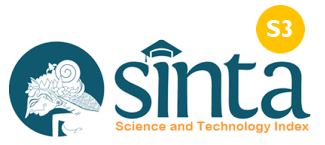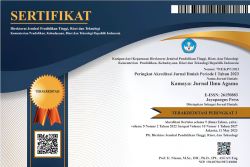The Role Of Hindu Family In Shaping The Character Of Suputra Children
DOI:
https://doi.org/10.37329/kamaya.v6i3.2644Keywords:
Hindu Family, Suputra Child Character, Value of Hindu Religious EducationAbstract
Religious education seeks to shape the character of children. The role of the family in shaping the character of young generation children becomes essential. The primary and first education is done in the family environment. The lack of ethical education and character in the family environment causes the learners' personalities to deviate from the norms and ethics in the community; teaching in the family sector, schools, and society becomes the determinant in the character formation of children. This research finds some results: first, the pattern of guidance of character in Hindu family environment to form the personality and character of Hindu children, to form the character of child suputra. Ways of tolerance and tolerance in the Hindu family shape the character of suputra children. The pattern of disciplinary attitude building for Hindu children, children in Hindu family environments are familiarized with high discipline attitude. Second, obstacles are faced in shaping the character of children's suputra as the internal and external factors of family. Family families are less harmonious, and promiscuity is the cause of less optimal education in the family environment to form the character of children suputra. Third is the effort to provide education value tattwa, value susila, the value of the upacara, aesthetic value, and the existence of education and training in pasraman to pursue character education.
References
Adisusilo, S. (2012). Pembelajaran Nilai Karakter Konstruktivisme dan VCT. Sebagai Inovasi Pendekatan Pembelajaran Afektif. Jakarta: Rajawali Press.
Asmani, J. M. (2012). Pendidikan Berbasis Keunggulan Lokal. Jogjakarta: Diva Press.
Budiada, I. K. (2008). Sistem Pendidikan Anak Usia Dini Menurut Aagama Hindu Pada Keluarga di Kelurahan Kawan Kecamatan Bangli. Denpasar: Institut Hindu Dharama Negeri Denpasar
Darmadi, H. (2007). Dasar Konsep Pendidikan Moral Landasan Konsep Dasar dan Implementasi. Bandung: Alfabeta.
Fitri, A. Z. (2012). Pendidikan Karakter Berbasis Nilai dan Etika di Sekolah. Yogyakarta: Ar-Ruzz Media.
Gunawan, D. (2018). Penerapan konseling behavioral teknik modelling untuk mengatasi kecanduan game online pada anak usia 10 tahun. KONSELI: Jurnal Bimbingan dan Konseling (E-Journal), 5(2), 105-118.
Gunarta, I. K. (2020). Makna Teologi Mapepegat Dalam Upacara Ngaben Di Desa Tengkudak, Kecamatan Penebel, Kabupaten Tabanan. Jurnal Penelitian Agama Hindu, 4(3), 170-178.
Ihromi, T. O. (2004). Berbagai Kerangka Konseptual dalam Pengkajian Keluarga, Bunga Rampai Sosiologi Keluarga. Jakarta: Yayasan Obor Indonesia
Kiriana, I. N., Widiasih, N. N. S., & Suadnyani, I. G. M. R. (2023). Pelaksanaan Tradisi Aci Keburan di Pura Hyang Api Desa Pakraman Kelusa, Kecamatan Payangan Kabupaten Gianyar. Jurnal Penelitian Agama Hindu, 7(1), 33-45.
Kukuh, I. M. (2007). Pendidikan Budi Pekerti Dalam Membentuk Perilaku Siswa Suputra di SMP Negeri 1 Dawan. Klungkung: Institut Hindu Dharma Negeri Denpasar
Kurniawati, N. N., & Sutharjana, I. M. (2023). The Influence of Gadgets on The Development of The Early-Age Learners’ Behavior and Character. International Journal of Multidisciplinary Sciences, 1(2), 159-171.
Marsad, M. W. S. (2012). Penyelenggaraan Pendidikan Agama Hindu di SMP Negeri 2 Rogojampi UU RI No. 20 Tahun 2003 Tentang Sisdiknas. Denpasar: Institut Hindu Dharma Negeri Denpasar.
Miftahuddin, M. (2014). Moral Sosial Dalam Pengajaran IPS. Tribakti: Jurnal Pemikiran Keislaman, 25(2), 382-392.
Puspa, A. A. O., Hemamalini, K., Suhardi, U., & Kemenuh, W. (2020). Tradisi Reboan Sebagai Upacara Pitra Puja Pada Masyarakat Hindu Jawa Di Lampung (Kajian Komunikasi Sosio-Religius). Kamaya: Jurnal Ilmu Agama, 3(3), 259-272.
Shochib. (2010). Pola Asuh Orang Tua Dalam Membantu Anak Mengembangkan Disiplin Diri. Jakarta: PT Rineka Cipta
Slameto. (2010). Belajar dan Faktor-faktor yang Mempengaruhinya. Jakarta: Rineka Cipta
Subagiasta, I. K. (2008). Acara Agama Hindu. Surabaya: Pāramita.
Sudirga, I. B. (2007). Widya Dharma Agama Hindu: Pelajaran Agama Hindu untuk Kelas XI SMA. Bandung: Ganeca Exact.
Redana, I. W. (2023). Implementation of Tri Hita Karana Teachings to Shape the Character of Early Children. International Journal of Multidisciplinary Sciences, 1(2), 241-252.
Rochaety, E., Rahayuningsih, P. & Gusti Yanti, P. (2010). Sistem Informasi Manajemen Pendidikan. Jakarta: PT. Bumi Aksara
Titib. I M. & Sapariani, N. K. (2006). Keutamaan Manusia dan Pendidikan Budi Pekerti. Surabaya: Paramita.
Utama, I G. A. A. W. P. (2005). Kajian Tentang Aplikasi Kurikulum Berbasis Kompetensi Dalam Pembelajaran Agama Hindu di SMA Dwijendra Denpasar. Denpasar: Institut Hindu Dharma Negeri Denpasar.
Yusuf, L. N. S. & Nurihsan, J. (2011). Teori Kepribadian. Bandung: PT Remaja Rosdakarya.
Downloads
Published
How to Cite
Issue
Section
License
Copyright (c) 2023 Kamaya: Jurnal Ilmu Agama

This work is licensed under a Creative Commons Attribution-ShareAlike 4.0 International License.
An author who publishes in the Kamaya : Jurnal Ilmu Agama agrees to the following terms:
- Author retains the copyright and grants the journal the right of first publication of the work simultaneously licensed under the Creative Commons Attribution-ShareAlike 4.0 License that allows others to share the work with an acknowledgement of the work's authorship and initial publication in this journal
- Author is able to enter into separate, additional contractual arrangements for the non-exclusive distribution of the journal's published version of the work (e.g., post it to an institutional repository or publish it in a book) with the acknowledgement of its initial publication in this journal.
- Author is permitted and encouraged to post his/her work online (e.g., in institutional repositories or on their website) prior to and during the submission process, as it can lead to productive exchanges, as well as earlier and greater citation of the published work (See The Effect of Open Access).
Read more about the Creative Commons Attribution-ShareAlike 4.0 Licence here: https://creativecommons.org/licenses/by-sa/4.0/.





